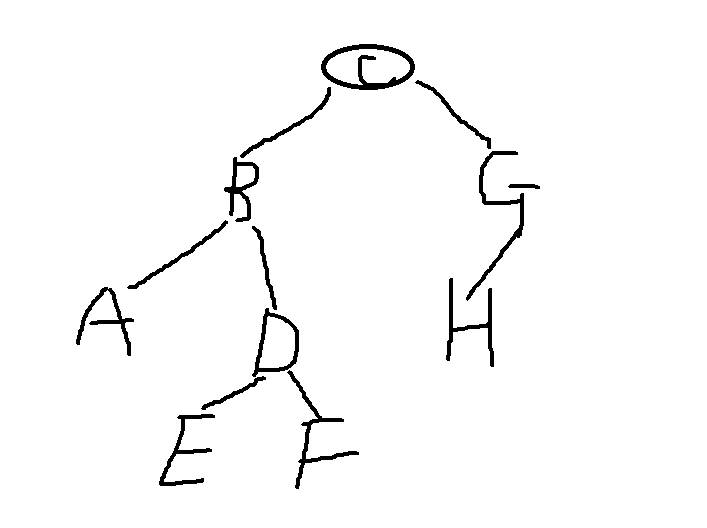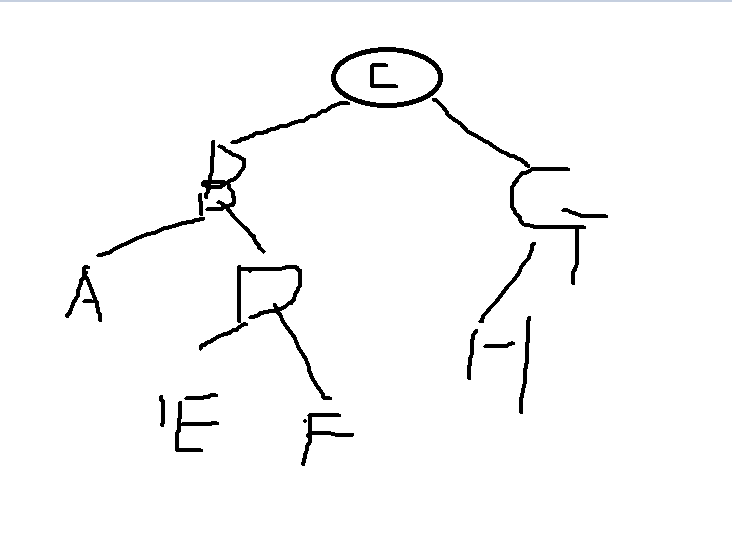1, Binary tree reconstruction
Binary tree reconstruction refers to the reconstruction of binary tree through pre order and middle order, or middle order and post order.
2, Constructing binary tree with middle order and pre order
Two sequences are given:
Preamble: CBADEFGH
Middle order: ABEDFCHG
How to launch the post order?
First, we know that the traversal order of the preamble is about the root
The traversal order of the middle order is left root right
Therefore, the first in the preamble is the root node of the whole root number
Then go to the middle order to match. The left is the left subtree of the root node, and the right is the right subtree of the root node
First time: the root is C
Left subtree: ABEDF
Right subtree: HG
Second time: root is B
Left subtree: A
Right subtree: EDF
The third time: the root is A
Left subtree: None
Right subtree: None
The fourth root is D
Left subtree: E
Right subtree: F
The fifth root is E
Left subtree: None
Right subtree: None
The sixth root is F
Left subtree: None
Right subtree: None
The seventh root is G
Left subtree: H
Right subtree: None
The eighth root is H
Left subtree: None
Right subtree: None
The tree diagram is:

Postorder traversal also looks good: AEFDBHGC
How to implement the code?
Analysis: once the pre order is known, the root node of the left subtree is the previous + 1 every time, and the root node of the right subtree is the root node + 1 found in the middle order traversal. The tree can be reconstructed after repeated. Here I print out the post order directly:
1 #include "bits/stdc++.h" 2 using namespace std; 3 char m[110],p[110];//m Is the middle order, p Is the preamble 4 void printAft(int pmiddle,int ppre,int len) 5 { 6 if(len == 0)//Return to the leaf node 7 return; 8 int i = 0; 9 while(m[pmiddle + i] != p[ppre])//According to the root node, the left and right subtrees of the root node can be found in the middle order 10 i++; 11 //The subsequent printing order is left and right root 12 printAft(pmiddle,ppre + 1,i);//The first represents the starting position of the order in the left subtree, the second represents the subscript of the next root node in the next left subtree, and the third represents the length of the left subtree 13 printAft(pmiddle + i + 1,ppre + i + 1,len - i - 1);//The first represents the starting position of the order in the right subtree, the second represents the position of the next root node in the previous order, and the third represents the length of the right subtree. 0 is the return print root node 14 cout << p[ppre]; 15 } 16 int main() 17 { 18 cin >> m; 19 cin >> p; 20 printAft(0,0,strlen(p)); 21 return 0; 22 }

Realize tree composition and Reprint:
1 #include "bits/stdc++.h" 2 using namespace std; 3 char m[110],p[110];//m Is the middle order, p Is the preamble 4 struct node{ 5 char date; 6 node *left; 7 node *right; 8 }; 9 node *find_Tree(int pmiddle,int ppre,int len) 10 { 11 if(len == 0)//Return to the leaf node 12 return NULL; 13 int i = 0; 14 node *T = new node(); 15 T->date = p[ppre]; 16 while(m[pmiddle + i] != p[ppre])//According to the root node, the left and right subtrees of the root node can be found in the middle order 17 i++; 18 T->left = find_Tree(pmiddle,ppre + 1,i); 19 T->right = find_Tree(pmiddle + i + 1,ppre + i + 1,len - i - 1); 20 return T; 21 } 22 void printAft(node *root) 23 { 24 if(root == NULL) 25 return; 26 printAft(root->left); 27 printAft(root->right); 28 cout << root->date; 29 } 30 int main() 31 { 32 cin >> m; 33 cin >> p; 34 node *root; 35 root = find_Tree(0,0,strlen(p)); 36 printAft(root); 37 return 0; 38 }
3, Middle order and post order construct binary trees (easy to confuse)
The only step to construct a binary tree is to find the root from the last order
Later: AEFDBHGC
Middle order: ABEDFCHG
Practical operation:
The first root is C
Order discovery in search
Left subtree: ABEDF
Right subtree: HG
The second root is B
Left subtree: A
Right subtree: EDF
The third root is A
Left subtree: None
Right subtree: None
The fourth root is D
Left subtree: E
Right subtree: F
The fifth root is F (note that this root corresponds to the position of the previous position of the root found in the middle order in the rear order, otherwise it is easy to be confused)
Left subtree: None
Right subtree: None
The sixth root is E
Left subtree: None
Right subtree: None
The seventh root is G
Left subtree: H
Right subtree: None
The eighth root is H
Left subtree: None
Right subtree: None
The tree diagram is:

How do you implement the code?
Analysis:
First, we go back and find the first root node
At this time, the start of the left subtree is pre, the next root node is i-1, and the length is i
The right subtree starts at i, the next node is at i+2, and the length is len - i - 1